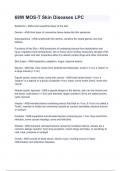68W MOS-T Skin Diseases LPC
Epidermis - ANS-most superficial layer of the skin
Dermis - ANS-thick layer of connective tissue below the thin epidermis
Subcutaneous - ANS-underneath the dermis, contains fat, sweat glands, and hair
follicles
Functions of the Skin - ANS-protection of underlying tissues from dehydration and
injury, regulates body temperature, site of many nerve ending, temporary storage of fat,
glucose, water and salt. properties allow it to absorb certain drugs and other chemicals
Skin Exam - ANS-inspection, palpation, turgor, observe lesions
Macule - ANS-flat, color varies from white/brown/red/purple, small (<1 cm), a "patch" is
a large macule (>1 cm)
Papule (warts, some moles, some skin cancer - ANS-solid raised lesion <1cm, a
"plaque" is a papule or a group of papules >1cm, warts, some moles (nevi), some skin
cancer
Nodule (cysts, lipomas) - ANS-a papule deeper in the dermis, skin can be moved over
the lesion, solid lesion >1-2cm and elevated, larger nodules (>2cm) are called tumors,
cysts, lipomas
Vesicle - ANS-elevated lesion containing serous fluid that is <1cm, if >1cm it is called a
"bulla", vesicles or bullae are commonly caused by contact dermatitis, physical trauma
or sunburn
Pustules - ANS-superficial and elevated lesions containing pus <1cm, they result from
infection, some causes impetigo, acne and folliculitis
Wheals - ANS-transient, elevated lesions caused by localized edema, wheals are a
common allergic reaction, from drug eruptions, insect stings and bites, or sensitivity to
cold, heat, pressure or sunlight
Crusts - ANS-consist of dried serum, blood or pus, crusting occurs in many
inflammatory and infectious diseases




